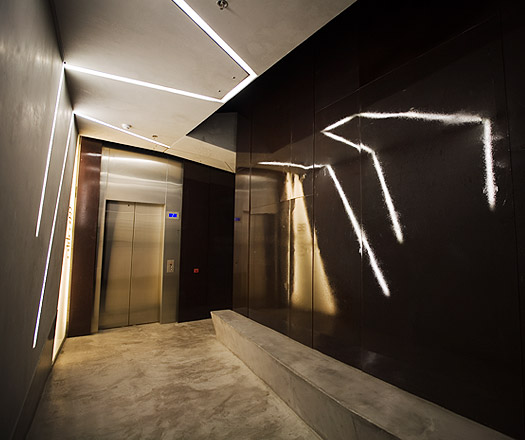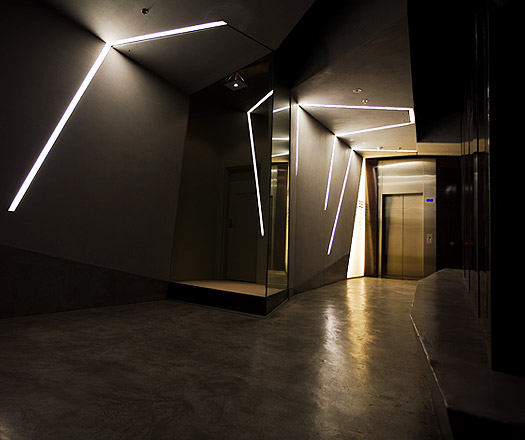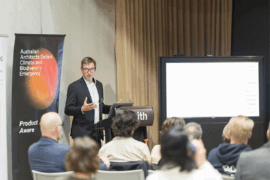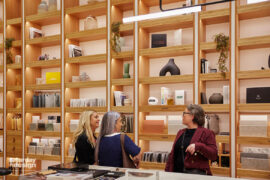Terroir Architects heritage refurbishment of 88 George Street, in The Rocks, Sydney, takes out another award.
September 29th, 2009
The refurbishment of the heritage-listed 88 George Street by Terroir architects has been awarded once again, receiving an award in the sustainability category of the Australian Institute of Project Management awards.
The project, completed last year, sees ultra-modern additions to an historic building, creating a clear delineation between old and new.
The firm was required to maintain the ‘heritage fabric’ of the exterior walls, but employed two ‘key interventions’ – an external triangular public space and an internal foyer.
Outside the building, what was an under-utilised triangle of land has been transformed into a dynamic public space. By analysing the existing topography Terroir have created a ‘single fluid plate’ from the different levels, as though the space rambles down the natural slope.
A steel and glass canopy sits in the north-east corner of the outdoor space, providing shade and protection for tenants and tying the project to the nearby Sydney Harbour Bridge.
The ground floor foyer was conceived as a bridge linking George Street to the existing lift core – described by the architects as a ‘singular folded concrete tube’, the aim was to provide a “dramatic ‘pause’ between street and office”.
This concrete tube is the focus of a Klik Systems custom-designed lighting installation – using the 85 Beam RV– embedded into the very fabric of the building itself, employing the same dynamic angles of the internal and external modern additions.
Showing that heritage buildings can sit side-by-side with modern architecture and materials, 88 George Street certainly sets the benchmark for similar heritage refurbishments.
In 2008 the project also won the Environ BPN Sustainability Award for large commercial projects, the Energy Australia National Trust Heritage Award for Conservation Energy Management and was the first State heritage listed building to receive a GBCA 5 star Green Star office rating.’¨


INDESIGN is on instagram
Follow @indesignlive
A searchable and comprehensive guide for specifying leading products and their suppliers
Keep up to date with the latest and greatest from our industry BFF's!

For Aidan Mawhinney, the secret ingredient to Living Edge’s success “comes down to people, product and place.” As the brand celebrates a significant 25-year milestone, it’s that commitment to authentic, sustainable design – and the people behind it all – that continues to anchor its legacy.

A longstanding partnership turns a historic city into a hub for emerging talent

Welcomed to the Australian design scene in 2024, Kokuyo is set to redefine collaboration, bringing its unique blend of colour and function to individuals and corporations, designed to be used Any Way!

London-based design duo Raw Edges have joined forces with Established & Sons and Tongue & Groove to introduce Wall to Wall – a hand-stained, “living collection” that transforms parquet flooring into a canvas of colour, pattern, and possibility.
A night of decadence, indulgence and blazing genius set to challenge the moral fibre of the most righteous soul. some of Sydney’s most extraordinary performers will sing, dance, and fly their way into your laps. Featuring folk from Legs, Circus oz, Priscilla, six Quick Chicks, the band d.i.g. and a special appearance by tim Freedman as you have never seen him before. think of this fundraiser as a pair of beautiful stockings that will support your Legs – letting them thrill, entertain and enthrall many an audience to come.
Garden Life celebrated their 7th Birthday with an evening of winter warmth at their Darlinghurst outdoor store on Wednesday 24 June.
From 15 March until 12 May 2012 artist Christina Waterson presents her latest solo exhibition, ’Trace’, as part of the L’Oreal Melbourne Fashion Festival Cultural Program and presented by How We Create. Brisbane-based artist Christina Waterson brings to her work a unique perspective as a Queenslander and as an architect. Her art explores strong shapes […]
The internet never sleeps! Here's the stuff you might have missed

In a landscape clouded by data and greenwash, Product Aware offers architects and designers a common language for sustainability. Embraced by suppliers – including Milliken – it is setting a new benchmark for trust and bringing clarity and accountability to material specification.

Saturday Indesign lit up the CBD and South Melbourne with design, wellness, hospitality, and community in a day full of creativity and connection.